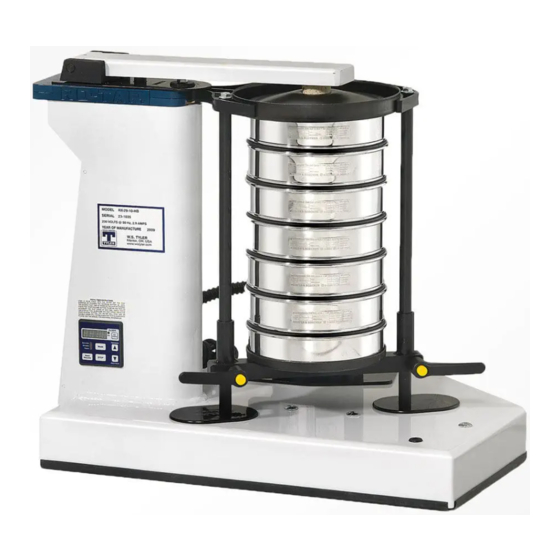
Table of Contents
Advertisement
Advertisement
Table of Contents

Summary of Contents for Tyler Ro-Tap RX-30
- Page 2 E Twin Nut Clamping System Ro-Tap ® E Parts List Ro-Tap Standard Test Sieve Analysis 14-16 Limited Warranty and Limitation ™ W.S. Tyler Mentor, Ohio © Copyright 2010, Haver Tyler, Inc. All rights Reserved ® is a registered trademark of Haver Tyler, Inc. Ro-Tap...
- Page 3 BASIC INFORMATION Installation ® The sieve shakers (Ro-Tap Models RX-29 & RX-30 & Coarse Model RX-812) must be mounted on a ® Ro-Tap Test Stand (R-40041), concrete foundation or heavy bench capable of supporting 200 lbs. Moderate tension of the mounting bolts is all that is required. Basic Operation ®...
- Page 4 Replace pedestal cover. Lubrication The Tyler Sieve Shakers require only minimal periodic lubrication. The units incorporate plastic and oil- impregnated bronze bearing materials, which are self-lubricating. A few drops of light oil or WD-40™ every six months is all that is necessary to prevent drying of the parts. Application of the same lubricants will suffice if a squeak or a drag should develop in the mechanism.
- Page 5 RX-29 & RX-30 Ro-Tap PARTS DIAGRAM ®...
-
Page 6: Parts List
RX-29 & RX-30 Ro-Tap PARTS LIST ® PART DESCRIPTION ITEM PART DESCRIPTION REQ’D REQ’D 107770 Base R-40037 Electronic Timer (230v) R-20029 Hammer R-40040 Timer Mounting Clip R-20023 Hammer Block P-1500- Motor-Standard 115/230v 60/50Hz 1Phase R-30019 Sheet Guard ZF10183 3/8-16 x 1” Hex Flange Bolt R-30010 Rotating Guard R-10058... - Page 7 RX-94 Ro-Tap II PARTS DIAGRAM ®...
- Page 8 RX-94 Ro-Tap II PARTS LIST ® ITEM PART DESCRIPTION PART DESCRIPTION REQD REQD R-40023 Painted Base Weldment 106582 ½” I.D. Shim ZA11167 Grommet ZF10222 ½”-13 Locknut R-10117 Gasket Channel R-10036 Lift Rod R-10061 Flanged Bearing R-10030 Lift Rod Coupling R-10062 Bearing ZF10251 5/16-24 x 1/25”...
- Page 9 RX-812 COARSE SIEVE SHAKER PARTS DIAGRAM...
- Page 10 RX-812 COARSE SIEVE SHAKER PARTS LIST ITEM PART DESCRIPTION QTY. LC10016 Locating Pin LC10017 Clamping Knobs LC10018 Clamp Bar LC10015 Clamping Rods P-1500-23 Motor ¼ HP 115/230V 60/50 Hz 1 Phase R-10112 Flexible Conduit Connector 102542 Oilite Flexible Conduit – 8-1/2” ZA10956 10-24 Cup Point Set Screw LC10014...
- Page 11 Ro-Tap ® Model RX-29-E...
- Page 12 STARTING AND OPERATING Set values Actual values Entry keys Left (-) Right (+) Starting the Machine main switch Switch on the machine with the (located at the rear of the unit). All Indicators on the front panel will read “0”. Time The sieving time is shown in minutes (99 minutes maximum) and appears in the indication field of set values/actual values.
- Page 13 NEW HAVER TWINNUT CLAMPING SYSTEM The new ‘Haver TwinNut’ clamping system perfectly combines the advantages of the previous Classic and Easylock Systems Function: The sieve is fixed using the nuts in the same way as the Classic system (1.0 + 3.0). Varying heights of the sieve tower are achieved by opening the TwinNuts (2.0).
- Page 14 RX-29 E Ro-Tap PARTS DIAGRAM AND PARTS LIST ® Item # Piece Designation Article # Nuts for clamping system Easy Lock® 00560129 Inspection glass without hole for machine cover (dry) 00561499 Inspection glass with hole for machine cover (wet) 00561507 Cover with inspection glass 00561521 Cover without inspection glass...
- Page 15 TEST SIEVE ANALYSIS Test Equipment Test sieves “nest” together to form a “stack” of sieves. In most sieving tests the 8 inch diameter sieve is used. A test sieve shaker that provides both circular and tapping energy is recommended. Uniform mechanical motion will provide the most consistent results.
- Page 16 The key to successful, repetitive particle analysis is developing standard testing procedures. Basic Elements of Testing 1. Sample Preparation. 2. Test sample sizes or weights. 3. Test Equipment. 4. Testing times or intervals. 5. Recording results. Sample Preparation When deciding how much material to test, consider the type of material, screen ability of the material and the range of particle sizes.
- Page 17 Static Electricity Some materials generate static electricity during the dry sieving process. When particles “charge” themselves as they come in contact with other particles, they stick to the metal frame and cloth of the sieve. This prevents you from obtaining accurate results. As a suggestion: ...
Need help?
Do you have a question about the Ro-Tap RX-30 and is the answer not in the manual?
Questions and answers